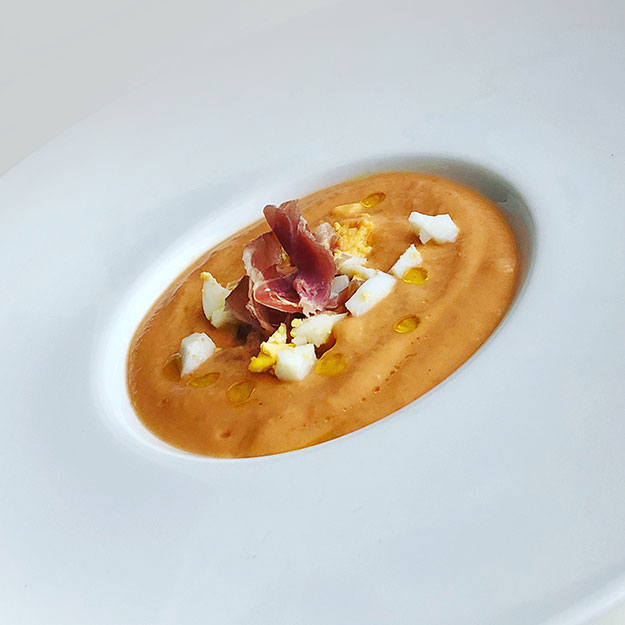.png.transform/rendition-xs/image_image%20(1).png)
The Gazpacho and Salmorejo Tour
From its humble origins as a favorite snack of Andalusian peasants, gazpacho, a cold soup made with raw ingredients, has risen to the menus of sophisticated restaurants all over the world. Andrea Aguilar reviews the origins, the places, the restaurants ante the variations that make it essential to surviving a hot summer
It is said that Empress Eugenia (or Eugenie) de Montijo was the first to take it international, since she insisted on serving it during her wedding banquet when she married Napoleon III in 1853. Back in the 1980s, Almodóvar's Women on the Verge of a Nervous Breakdown significantly contributed to its fame by adding a modern (or perhaps post-modern) pinch to the traditional recipe and presenting it as a perfect disguise for Valium. More recently, Spanish world-class chefs such have successfully explored its endless possibilities. So gazpacho, together with siesta and fiesta, is now firmly established in the international lexicon.
The beginning of this Cinderella story is still unclear, though most experts agree that the original formula, whose basic ingredients appear to have been old bread, olive oil and garlic, was born once upon a time in Andalusia, when the Romans conquered the Peninsula. The Moors lent their refined taste to the primitive gazpacho by adding almonds to the recipe, giving birth to ajoblanco. Spaniards generally refer to this cold soup as the precedent of modern gazpacho. Hence, before tomatoes, peppers and cucumbers were brought back from the New World, the refreshing soup was white.
Nowhere Like Home

Gazpacho has undergone countless transformations but garlic, salt and olive oil have always been its three core ingredients. New technological devices such as the refrigerator and the food processor have played an important role in its modern day cold serving temperature and creamy texture, but no one agrees on this soup's canon. Many Spaniards will engage in verbal violence if the subject of gazpacho subject is raised: cumin, carrots and cucumbers rank among the most controversial ingredients, which can lead to endless discussions and can jeopardise life-long friendships. "There's no gazpacho like the one prepared at my house" is the common argument that everyone defends.
But even if no Spaniard will concede that any gazpacho could be better than his own, most of them give in and order this dish away from home. From May to September, in any bar or restaurant across the country, gazpacho is served. This said, it is accepted that Andalusia is the original birthplace of at least four of its most popular versions. Leaving aside the possible arguments that might ensue as to where to find the best bowl of gazpacho, a tour around different provinces of this region offers a good immersion into the subject.
When 'Gazpacho' is a Dip

Córdoba is our starting point. More bread, no water and no cucumber turn gazpacho into salmorejo, the speciality of this area. The resultant dense texture turns this dish into a dip rather than a soup. Though it may still be served in a bowl, it is not advisable to drink it but rather to eat it with bread or with the aid of a spoon, making salmorejo perfect for the tapas sharing protocol. It is usually served with toppings of chopped boiled egg and Serrano ham, which surely add to the dipping enjoyment. Sometimes crisp aubergine fritters are served alongside - a dipping heaven on earth.
Behind the emblematic mosque, which reminds the visitor of the nearly 700-year Moorish rule of the city, stands a classic where you can try it: El Churrasco restaurant. The building, which also has accommodation facilities, forms part of the city's beautiful Jewish quarter or judería. Following the Andalusian tradition, it has two patios, though the tables are distributed inside. The wooden ceilings, with beams in full view, set the stage for the classic menu that awaits the client. Along with the traditional salmorejo, ajoblanco ranks as another of this restaurant's specialities. A bit further away from the historical centre, the young and talented chef Kisko García sidesteps the rigour of tradition and offers some interesting adaptations of Andalusian cold soups in his restaurant El Choco.
An even denser version of salmorejo can be found in Antequera, a picturesque and beautiful town in the province of Málaga which has lent its name to a delicious variant of gazpacho: porra antequerana. Water and cucumber are also excluded from this recipe. In addition to ham and boiled egg, the porra's toppings include tuna and tomato wedges, anticipating the successful modern mixture of fish and seafood with gazpacho, a combination that has seduced modern chefs and clients. A traditional spot where this peculiar dish can be found is La Espuela, a restaurant next to the city's historic bullring.
White 'Gazpacho'
Leaving aside the density and going back to the more liquid versions of gazpacho, sunny Málaga has the best reputation for ajoblanco. The traditional toppings for this Moorish version of gazpacho exclude the egg, and obviously the ham, in favour of grapes. This province has contributed to the international impact of gazpacho since the 1950s thanks to its thirsty and hungry tourists.
Talented chefs have shaken the roots of traditional regional recipes and brought out revolutionary tastes and textures. A good example of this is chef Dani García who has gained international fame with his imaginative interpretation of cold soups. José Carlos García is another outstanding example of this modern cold soup trend. His delicious ajoblanco, which has captivated the experts, holds a place of its own in the cold soup tour.
Returning to the Classics
Back to basics, Seville is a good option to taste classic gazpacho. Here it is made with tomato, cucumber, garlic, onion, green pepper, bread, salt, a dash of sherry vinegar, olive oil and water and is usually seasoned with cumin. The diced ingredients can also be added to the soup as toppings. Served in a bowl, it is not shared, though it is offered in every tapas bar in the city. In the white and labyrinthine Santa Cruz quarter Las Teresas ranks among the most authentic bars in the area, where between sip and sip of refreshing soup, visitors can prepare themselves for another Spanish international tradition: the siesta.
Andrea Aguilar /©ICEX


